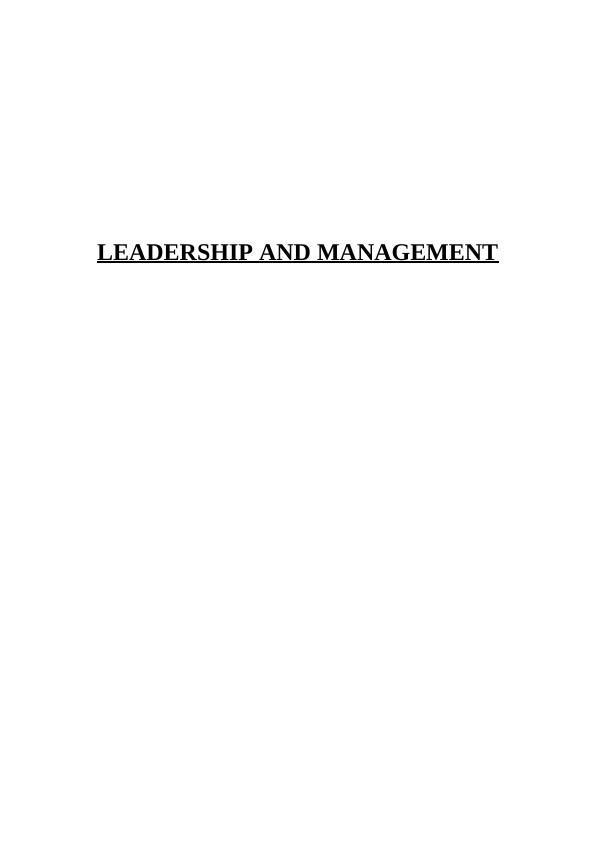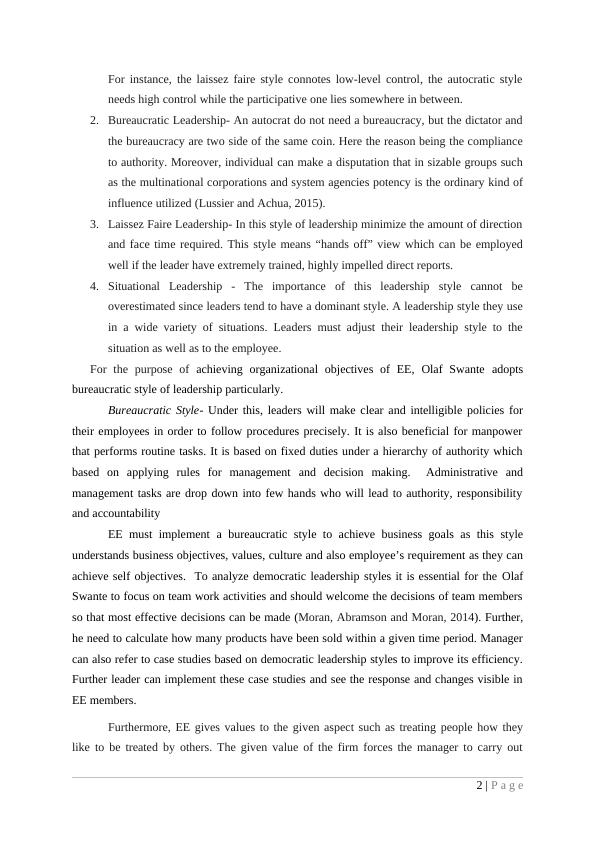Principles of Leadership Case Study
Added on 2019-12-03
11 Pages2999 Words118 Views
LEADERSHIP AND MANAGEMENT

Table of ContentsIntroduction................................................................................................................................1Leadership style of Olaf Swantee...............................................................................................1Change models used in the takeover..........................................................................................3Managing resistance to change...................................................................................................4Conclusion..................................................................................................................................6References..................................................................................................................................7

INTRODUCTION Leadership is considered as a central role which drives organization towards itsobjectives. In the given case study of Olaf Swantee, chief executive of EE, leader has toapply principles of leadership which will help the business to extend its growth in making itsuccessful. On the other hand, management deals in achieving goals and objectives in anefficient and effective manner (Bassi, Ranzani and Torres, 2013). Leadership helps themanagement to create a vision for future. The company undertaken in this report is EE whichis the British Telecom service company and is considered as one of the largest telecomcompany in the world. This Organization consists of wide-range of services with excellent quality and brandimage. EE has expanded its business around UK with Integration ofOrange and T-Mobilewhich has been a major task and it is currently having approx 6350 stores and more thanthousands of employees working in the company. This present report is based on analyzingthe impact of organizational objective on leadership style and management role. Further, itevaluates the change model and management skills and manages resistance to change thedevelopment which is required in achieving organizational objectives.LEADERSHIP STYLE OF OLAF SWANTEEThe objectives, value and culture that is being followed by the firm causes necessaryimpact upon the leadership and management. This is because, on the basis of given aspectonly the manager of EE has to carry out significant changes in its way of managing anddealing with the people. In this context, from the analysis it has been identified that, EE hasthe major objective to provide best and high quality of services to the buyers. The givenobjective of firm can be met if manager manages and leads its employees in an effective way(Landsberg, 2015). Thus, with an aim to carry out best from the employees’ manager of EEhave to use participative leadership style in which all the employees take part in decisionmaking process. This motivates the workers as they feel they are part of great family. Inaddition to this, by using the given styles only opinions of the EE employees can be gatheredregarding the skill which they want to improve (Fisher and Briel, 2012). Thus, by taking theappropriate action against the communicated skill the cited objective of firm can be met. The different types of leadership are as follows:1.Autocratic Leadership – in this leadership style magnitude is connected with controland individual's representation of how much control individual should give to others.1 | P a g e

For instance, the laissez faire style connotes low-level control, the autocratic styleneeds high control while the participative one lies somewhere in between.2.Bureaucratic Leadership- An autocrat do not need a bureaucracy, but the dictator andthe bureaucracy are two side of the same coin. Here the reason being the complianceto authority. Moreover, individual can make a disputation that in sizable groups suchas the multinational corporations and system agencies potency is the ordinary kind ofinfluence utilized (Lussier and Achua, 2015).3.Laissez Faire Leadership- In this style of leadership minimize the amount of directionand face time required. This style means “hands off” view which can be employedwell if the leader have extremely trained, highly impelled direct reports.4.Situational Leadership - The importance of this leadership style cannot beoverestimated since leaders tend to have a dominant style. A leadership style they usein a wide variety of situations. Leaders must adjust their leadership style to thesituation as well as to the employee.For the purpose of achieving organizational objectives of EE, Olaf Swanteadoptsbureaucratic style of leadership particularly.Bureaucratic Style- Under this, leaders will make clear and intelligible policies fortheir employees in order to follow procedures precisely. It is also beneficial for manpowerthat performs routine tasks. It is based on fixed duties under a hierarchy of authority whichbased on applying rules for management and decision making. Administrative andmanagement tasks are drop down into few hands who will lead to authority, responsibilityand accountabilityEE must implement a bureaucratic style to achieve business goals as this styleunderstands business objectives, values, culture and also employee’s requirement as they canachieve self objectives. To analyze democratic leadership styles it is essential for the OlafSwante to focus on team work activities and should welcome the decisions of team membersso that most effective decisions can be made (Moran, Abramson and Moran, 2014). Further,he need to calculate how many products have been sold within a given time period. Managercan also refer to case studies based on democratic leadership styles to improve its efficiency.Further leader can implement these case studies and see the response and changes visible inEE members.Furthermore, EE gives values to the given aspect such as treating people how theylike to be treated by others. The given value of the firm forces the manager to carry out2 | P a g e

End of preview
Want to access all the pages? Upload your documents or become a member.
Related Documents
Leadership And Change Management Assignment Solutionlg...
|14
|3997
|159
Leadership and Change Management (PDF)lg...
|9
|3259
|281
Leadership and Change Management : PDFlg...
|11
|3455
|345
Organisational Structures and Culture - Doclg...
|8
|2051
|397
Leadership and Management for Servicelg...
|13
|478
|21
An Analytical Study of Strategy Implementation in Vodafonelg...
|18
|1500
|267